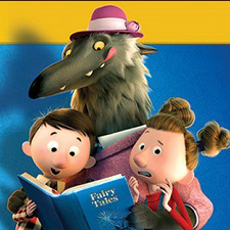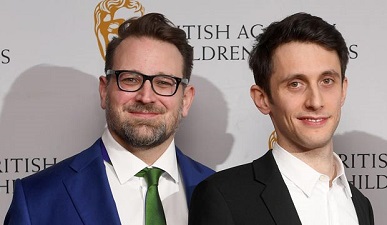 Based on the extraordinary book written by Roald Dahl and illustrated by Quentin Blake, Revolting Rhymes mixes the classic fairy tales of Little Red Riding Hood, Snow White, The Three Little Pigs, Jack & The Beanstalk and Cinderella, and serves them with a mischievous twist. The 30-minute-animated short was directed by Oscar nominees Jakob Schuh (The Gruffalo) and Jan Lachauer (Room On The Broom), co-directed by Bin Han To and produced by Magic Light Pictures’ Martin Pope and Michael Rose (The Gruffalo, Room On The Broom, Chico And Rita). The animation was created at Magic Light’s Berlin studio and at Triggerfish Animation Studios in Cape Town. Revolting Rhymes interweaves Dahl’s retellings of classic fairy tales with playful twists and surprising endings. The all-star voice cast is comprised of Dominic West, David Walliams, Rob Brydon, Tamsin Greig, Bertie Carvel, Rose Leslie, Bel Powley, Gemma Chan and Isaac Hempstead Wright. Revolting Rhymes recently won a Children’s BAFTA, 2 European Animation Awards, a Cristal at Annecy, and was also just nominated for the Annie Awards and the Academy Awards for Best Animated Short.
Based on the extraordinary book written by Roald Dahl and illustrated by Quentin Blake, Revolting Rhymes mixes the classic fairy tales of Little Red Riding Hood, Snow White, The Three Little Pigs, Jack & The Beanstalk and Cinderella, and serves them with a mischievous twist. The 30-minute-animated short was directed by Oscar nominees Jakob Schuh (The Gruffalo) and Jan Lachauer (Room On The Broom), co-directed by Bin Han To and produced by Magic Light Pictures’ Martin Pope and Michael Rose (The Gruffalo, Room On The Broom, Chico And Rita). The animation was created at Magic Light’s Berlin studio and at Triggerfish Animation Studios in Cape Town. Revolting Rhymes interweaves Dahl’s retellings of classic fairy tales with playful twists and surprising endings. The all-star voice cast is comprised of Dominic West, David Walliams, Rob Brydon, Tamsin Greig, Bertie Carvel, Rose Leslie, Bel Powley, Gemma Chan and Isaac Hempstead Wright. Revolting Rhymes recently won a Children’s BAFTA, 2 European Animation Awards, a Cristal at Annecy, and was also just nominated for the Annie Awards and the Academy Awards for Best Animated Short.
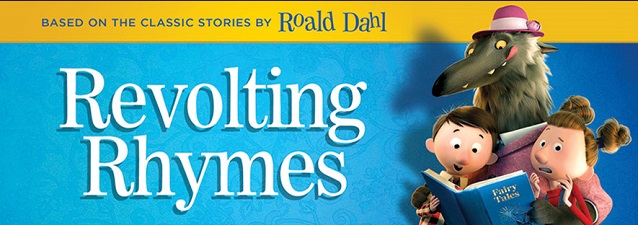
AnimatedViews: How did you discover Roald Dahl’s novel?
Jakob Schuh & Jan Lachauer: We’re both from Germany, and this particular book of Dahl’s had never been translated into German when we were younger. Still hasn’t, actually. We’ve always been massive Dahl fans, having grown up both on his and illustrator Quentin Blake’s work. So when Martin Pope (from production company Magic Light Pictures) sent us Revolting Rhymes, it was a bit like hearing a fantastic song of your favourite band for the first time – decades after that band stopped playing. Admittedly, everyone else knew the “song” by heart and considered it a classic, but, well, we didn’t. It was exciting, and actually quite touching. Also, reading – for the first time – a book that you’re asked to adapt is a slightly specific reading experience, you want go to it very open, because that first impression a text makes on you is very hard to recreate later and we feel it’s often crucial in finding the essence of a story and its tone.
Revolting Rhymes as a book had so much going for it: Dahl’s rhyming is just wonderful, the world view he puts down is often shockingly timely, the themes of female empowerment, revolt, his take on materialism and tradition… it’s a gift to be allowed to work with that kind of source material.
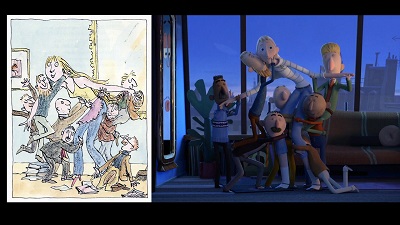
AV: How did the idea of making a short film out of it take shape?
JS&JL: When we were approached with the book by Martin Pope, he didn’t give us a strict format to work in initially. The Dahl estate was also very open to ideas. The book consists of six separate stories, so we could have probably picked a few and made a little short film of each. But the tone of Dahl’s narration felt like these poems belonged together on a deeper level all along. There’s a beautiful connecting motif permeating the book: It’s all about fiercely determined female protagonists revolting against pretty much everyone else trying to screw them over.
So, we decided to try and let the tales of these young women play out in a shared universe, simultaneously, nudging each other along. It felt exciting but, on a technical level, writing this became a lot trickier than we thought, just because all dialogue is rhymed. We didn’t want to change or add to Dahl’s rhyming or break the flow of his couplets. So, whenever we would jump between stories or wanted unconnected story arcs to join and influence one another, it had to be done wordlessly or by using existing couplets in an unexpected way. Overall, the adaptation was a tough nut to crack, and it took a long time, but it always felt worth it because each story would give so much to the other once you found that one interesting way to conjoin them.

AV: In what way does that story lend itself to animation?
JS&JL: Regarding Dahl in general, we’d discussed that a number of times over the years, how peculiar it is that Dahl keeps on being adapted mainly into live-action films, often times with his specific warmth clashing slightly with the harshness that VFX-heavy live action can sometimes have. It feels kind of counterintuitive. We always preferred the somewhat less realistic portrayals of Dahl’s world: animation or, for example, Tim Minchin’s Broadway version of Mathilda, which brings its own kind of perfect stylization to the text. Also, while we very much understand why no one – including us – thinks it’s a promising idea to try and animate Quentin Blake’s ink drawings (to us it would have felt like blasphemy) we never understood why so very few adaptations try and honor the genius that lies beyond his matchless linework: his gorgeous shape language, expressive poses, the fantastic silhouettes. Most of the adaptations usually don’t go beyond some nods to his costume design, but there’s so much more goodness in these drawings.
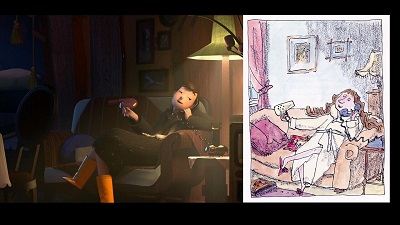
AV: So, it’s more about the spirit of his drawings that you kept?
JS&JL: We both grew up on Quentin’s illustrations, we’re slightly obsessive fans. So, to us the idea of adapting Quentin’s work was just as exciting and daunting as the idea of adapting Dahl’s words. Also, Quentin is very much alive, he’s around and saw the project in development, so you really want to make good use of that fact. Even when we did the very first tests, at times dabbling with the idea to do the film in 2D, we never even talked about attempting to copy Blake’s actual drawing style, his linework. You’d set yourself and the viewer up for disappointment. But Blake’s interpretations of Dahl’s words have so much to give beyond his wonderful, meandering linework. The characters he invents in his drawings are such an integral part of the Dahl-universe, to us but also to many readers. So not incorporating the core of his character designs, their shapes and their form, that also would have felt like leaving an essential part of the book behind. So we set out to keep his characters, get close to the essence of their volumes and silhouettes without copying his style, his linework. It felt right to give the viewer a version of those stories that is its own thing, but doesn’t visually contradict the books. The basic rule was: When you go back to the book after seeing the film, you find the same characters in the same situations, sometimes even the same poses. Ours are just very obviously sculpted instead of drawn, an interpretation of that same character design by a different, hopefully able, artist.
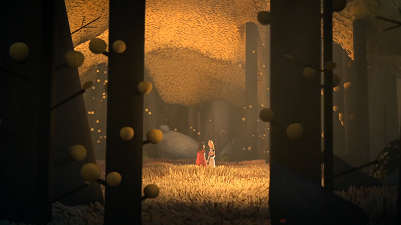
AV: How did you create the visual style of the film?
JS&JL: There’s two worlds in that film, with slightly different design approaches. The majority of the action takes place in the more stylized fairytale world. That’s also the place shown in all of Blake’s original illustrations. For our first meeting about the project, the two of us met in a café we both like a lot, in Munich, which is the town we’re both from originally. That place is part of an old museum which houses, amongst other things, a great collection of pretty ancient marionettes and puppets. We both hadn’t been up there since we were kids so we thought we might as well take a little tour.
Some of the marionettes and hand-puppets in that collection, their simple shapes and their carved and painted surfaces, and – just as importantly – the simple logic of those old puppet theatre stages, the flat set elements with their volumes just painted-on, all that became a big influence when we started imagining the look of our main story. We took a boatload of photos and videos that day and that file remained our main reference for the modeling and texturing of both characters and sets, more inspiring than anything we’d find elsewhere afterwards. Even when coming up with our own interpretation of Quentin’s wonderful character designs, the beautifully twisted old puppets seemed a very nice three-dimensional analogy to Quentin Blake’s simple shapes and twisted poses.
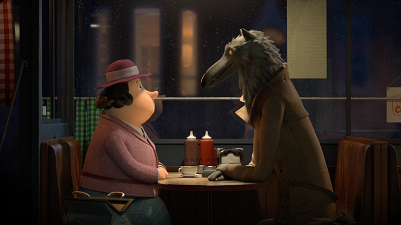
AV: How did you adapt Dahl’s original storyline?
JS: The ground rules we set for ourselves regarding the adaptation were pretty clear early on:
First off, Dahl’s original poems sport a very distinct narrator’s voice – there’s an underlying menace to it, alternating with great warmth and wisdom. And he makes it known that he has opinions about these stories. In the book that narrator is obviously Dahl himself. So, we felt we should give the viewer an equally distinct narrator figure, a stand-in for Dahl almost, and make sure that this character has real reasons for telling these stories. So that was the first thing, find a great narrator figure and give him an exciting agenda for the viewer to discover.
The other thing was to honor the sheer joy of Dahl’s rhymes. When you read these poems, you can almost see him, sitting in his writing hut, grinning at the madness of it all. We knew we needed to extrapolate some of the character arcs, but we really didn’t want to add to Dahl’s rhymes, they’re just too special. As a consequence, whatever we would add to his stories would need to done without adding any new rhymes – but also without these new sequences feeling “pantomime” in the framework of a script that’s otherwise pretty dense with dialogue.
The biggest rule was obviously to try and be faithful to the general tonality of Dahl’s stories, especially where we expanded them: Dahl wrote the book almost 40 years ago, but a lot of the action feels shockingly modern. There’s a spirit of resistance all over it, of setting things right; and whenever Dahl suddenly drags these classic tales into more daring territory, he does it in that spirit.
The kind of liberties Dahl takes when tackling these well-known stories, they define your own leeway in the writing process, he kind of points you in a direction: Added strands about a corrupt mortgage banker, new tales of shifty pigs in back rooms trying to get away with shifty things, or of a special bond formed between these two young women – it all very seemed to grow quite naturally from a perspective that Dahl had already sketched out in his rhymes.
JL: And then we both felt that it would be exciting to have Dahl’s stories, which are unconnected in his book, play out simultaneously in a shared universe. Theoretically, you could just cut back and forth between the different stories; but If you want to avoid multiple endings – which we did – you have to interweave the characters’ fates tightly enough for them to find one conjoined, hopefully relevant ending. And then you have to connect all that with your narrator figure somehow. Without adding new rhymes.
So, the goal was to weave together Red’s and Snow White’s story, create this special decade-long relationship they’re forming in the face of quite some adversity. We always loved the ways in which Dahl has each of these two young women triumph, and having them triumph together just felt right.
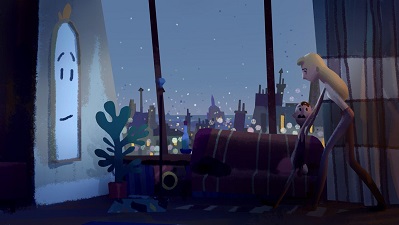
AV: Can you tell me about the challenge of having two remote studios working together on the same film? How did you share the task between Germany and South Africa?
JS&JL: The biggest factor in how the project was organized was that – as a sort of ode to Roald Dahl – we wanted the film to coincide with what would have been Dahl’s 100th birthday. That meant that we had a deadline that you really couldn’t move.
As you said, the two main teams were located in Berlin and in Cape Town. The authors of the source material – Dahl and illustrator Quentin Blake – are very much British obviously and so are the film’s producers, as well as the entire voice cast. The directors are German, but the Berlin team came from all corners of Europe and then our South African team was even more diverse. Everything started out with a very small studio in Berlin, with only the two of us sitting in a room, agonizing over the adaptation. We then moved into bigger studios twice as the team grew, and within half a year we ended up with a team of about 25 people here in Berlin. Although a few of our Berlin team members had worked with us before, in essence we had to find a completely new team for this project on our side, where all design work, storyboarding, editing, most of the modeling, a lot of the key shading and rigging, and about 50% of the animation was done. The other half of the animation plus the lion’s share of texturing and shading, all rendering, lighting and compositing was done in Cape Town by an amazing group of artists which we personally hadn’t worked with before as well, and who kind of had to hit the ground running once they joined the project.
Coordination between two teams on different continents isn’t easy, obviously, and we spent a lot of time on Skype as well as traveling back and forth, but the degree to which a lot of the artists over in Cape Town, especially the younger ones, identified with this project made the distances between the studios a lot shorter. As this production was a particularly close shave we ended the project with one director in London taking care of sound while the other one was in Cape Town finishing the picture. But after 16 months working pretty much at the same desk, there wasn’t a lot left that we hadn’t discussed and agreed upon at some point.
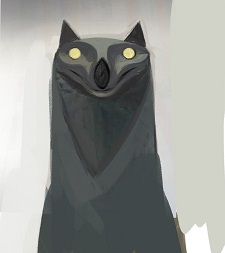
AV: What technical challenges did you face in the making of your movie?
JS&JL: For its length, Revolting Rhymes has an unusually large amount of characters and sets. Managing the design and creation of those while working in a visual style that we both hadn’t done before was certainly one big challenge. The other challenge was that very hard deadline – the Dahl centennial – a date that simply couldn’t be moved. Writing had taken a lot of time, and so production had to start midway through the boarding process, which is something you always want to avoid, normally. This created the need for a very tight, disciplined schedule where many things had to be done in parallel: design, animation, modelling all happened at the same time. It was a pretty complex project to organize.
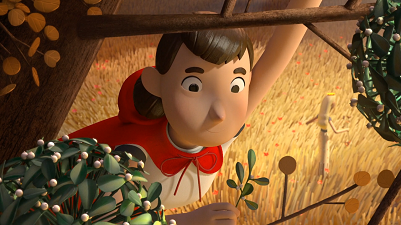
AV: What did you learn from that experience and what will you keep from it?
JS&JL: There’s maybe two main lessons we’ve learned while making Revolting Rhymes. The first is simple: Writing parallel, interconnected storylines creates really interesting results but it also makes everything else, from writing to final edit, exponentially more difficult. We surely didn’t anticipate how hard it would be to bring these four independent stories together in a meaningful way, having them coincide in one joint, relevant ending. It was great fun, but we now know what it means, work-wise.
The second lesson is more difficult to describe, but it’s probably something a lot of filmmakers can identify with. So you have a group of people believing in the potential of an idea and hence aiming for the impossible, trying to do something that seems unachievable within a given amount of time and money. Then the first really serious scheduling problems arise – it’s still very early in production – and we all sit down and discuss the problem. There’s a very human thing happening, because addressing a problem in its actual, scary size is exhausting. It’s so exhausting sometimes that it almost feels like working on the problem. But addressing a problem is not the same thing as solving it. You have to be very disciplined to never mistake one for the other. Sounds simple, but that mistake is made a lot. On this project there was no wiggle room for confusing the two, so every conversation had to end with everyone agreeing on actual real solutions.
We had several moments during the production where every one of us simply didn’t know if we’d ever finish the project in time. We kept going forward, learning, making sacrifices along the way, children were born, there was loss in the family, and it ended up being probably amongst the toughest months in our lives, but looking back, we do think it was worth the work. We really like what came of it.
Be sure to watch the trailer of Revolting Rhymes and to follow the movie on Instagram. With very special thanks to Jakob Schuh, Jan Lachauer and Fumi Kitahara.


